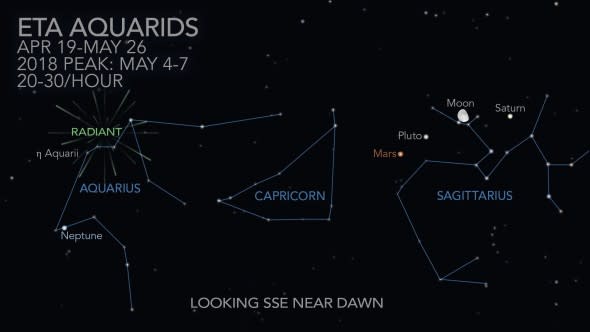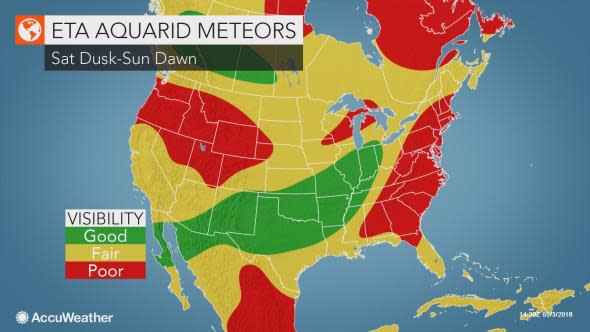Meteors to dash across weekend sky as Eta Aquarid shower reaches its lengthy peak
This weekend will feature the last meteor shower until late July with meteors streaking across the night sky all around the globe.
The Eta Aquarid meteors favors the Southern Hemisphere. It's considered one of the best meteor showers of the year for South America, Australia and parts of Africa, with up to 60 meteors an hour.
Some meteors will still be visible across the Northern Hemisphere, although in fewer numbers with 10 to 30 meteors an hour at the shower's peak.
Despite the lower rates in places such as North America, AccuWeather Astronomy Blogger Dave Samuhel said that this could be more active than the recent Lyrid meteor shower, which peaked in late April.
When the best time will be to look for meteors
Unlike most other meteor showers, the Eta Aquarids' peak lasts for several days.
"The Eta Aquarids are sparked by Haley's comet. This shower has a gradual peak that will span the entire weekend into Monday," Samuhel said.
"Sunday night may prove to be the most active night," Samuhel added.
The broad peak means that people will have several opportunities to look for meteors if the weather does not cooperate on a particular night.
Regardless what night people head outside to look for a few meteors, the best time to view the shower will be after midnight, although some meteors should be visible late in the evening.

"Unfortunately, widespread clouds will plague the East Coast this weekend," Samuhel said.
On Friday night, cloud cover hid the meteor shower from those in the Northwest and Northeast while clear skies reigned throughout the central and southwestern states.
Similar sky conditions are in the forecast across North America for Saturday night and early Sunday morning with the best conditions expected from Indiana to Texas and into Southern California.

Tips for seeing meteors this weekend
No special equipment is needed for viewing the shower, but being in an area with little light pollution will help to maximize the number of meteors that can be seen.
It may be difficult to spot some of the darker meteors during this year's Eta Aquarids as the moon will be shining brightly in the sky most of the night.
Because of this, Samuhel suggests picking an area of the sky opposite the moon to look for meteors.
"Let your eyes adjust to the darkness for at least 20 minutes. Do not look at the moon and stay off your phone. This will ruin your night vision," Samuhel said.
Even if the weather cooperates and onlookers are in an area far away from city lights, people may not see quite as many meteors as they expect.
"Meteor watching is a lot like fishing. Sometimes you catch a good number of them and sometimes you don't," EarthSky said.
The next major meteor shower will not be until the Southern Delta Aquariids reaches its peak at end of July.
Editor's note: The International Meteor Organization spells this meteor shower Eta Aquariids. Eta Aquariids are named for Eta Aquarii, the seventh star in the constellation, Aquarius.
Questions or comments? Email Brian Lada at Brian.Lada@accuweather.com and be sure to follow him on Twitter!
Follow @wxlada
